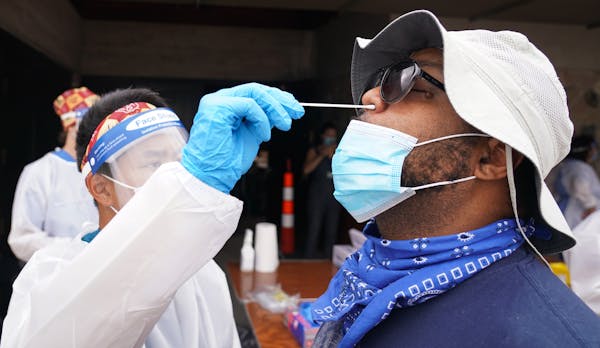Gov. Tim Walz urged Minnesotans to stick with COVID-19 safety strategies of mask-wearing and social distancing heading into a Labor Day weekend that could have a "big impact" on the rise or fall of the pandemic in the state.
"Six months ago it was my hope that we would be ... going to the State Fair, watching high school football, gathering to watch the Gophers on Saturday, all of those things," Walz said Thursday. "Well, the virus has not allowed us to do that, and we have to remain vigilant. We have got to stick with this."
Walz echoed concerns expressed earlier in the week by Dr. Deborah Birx of the White House COVID-19 task force and state Health Commissioner Jan Malcolm that people are being complacent in gathering with family and friends, and that the virus is taking advantage of those opportunities to spread.
An indoor wedding in southwestern Minnesota with more than 275 guests violated state capacity requirements of no more than 250 people in indoor venues, said Kris Ehresmann, state infectious disease director.
That event has so far resulted in 56 known infections — with reports of other attendees suffering illnesses but refusing testing — of people from nine different counties who may have spread the virus to others as well.
Positive cases from that outbreak included educators and workers in long-term care and health care, she added.
The Minnesota Department of Health has reported 1,837 COVID-19 deaths and 78,123 infections with the novel coronavirus that causes the infectious disease. That includes seven COVID-19 deaths and 1,047 infections reported on Thursday — though health officials said the daily case total was artificially inflated by belated reporting of some tests by private labs.
Minnesota remains at a tenuous position as it enters its seventh month of the pandemic.
The state reported that 272 people were hospitalized for COVID-19 and that 138 required intensive care due to breathing problems or other complications from their infections.
That daily number has remained fairly level throughout August and has declined this week — in part reflecting improved treatment with better oxygen management and new evidence that certain antiviral drugs and steroids work against COVID-19.
On the other hand, Birx warned Minnesota during a visit last weekend that its rate of new cases now exceeds the national rate. The state Health Department released data from a White House report showing a rate of 91 new cases per 100,000 people per week in Minnesota, compared with a national rate of 88.
While the Twin Cities defied some expectations by avoiding the kind of widespread outbreak that occurred in other large urban centers, it also hasn't seen its case counts recede as much as hoped this summer, Malcolm said.
"Frankly that's a concern for us that we didn't see that sustained decline during the warm weather months," Malcolm said, adding that the state is approaching the fall "in a much higher place than we had hoped to be."
Walz said political divisions have hurt Minnesota's COVID-19 response, but he stressed that his current recommendations are in lockstep with those coming from Birx and White House advisers — which could help convince opponents of the Democratic governor.
"If the mask issue hadn't become an us versus them type of thing, I think the vast majority of people would just do it," he said. "It's not fun. It's not all that pleasant, but they would do it."
Holiday weekends have not been kind to Minnesota amid the pandemic. Memorial Day weekend came at the height of the first wave of cases; the state had its worst day on May 28 with 606 hospitalizations and 35 deaths reported.
The Independence Day weekend marked a turning point in viral activity in Minnesota. Malcolm said average case growth was 482 per day before that weekend and is 732 now, and that the positivity rate of diagnostic testing has increased from 4.3% then to 5.5% now.
Infections resulting from unknown community sources also increased from 27.8% to 33.5% — reflecting the transition from traceable outbreaks in long-term care facilities and food processing plants to more elusive backyard gatherings and social events, she said.
"We're in a more precarious situation today than we were heading into the last major holiday weekend," she said, "and we just want Minnesotans to be aware there is risk in this situation. The virus is all over the state."

Trail section at one of Minnesota's most iconic spots closing for rehab

Will 'shotgun only' zone for deer in southern Minnesota be abolished?

Four Minnesotans catch salmonella in outbreak linked to basil sold at Trader Joe's

